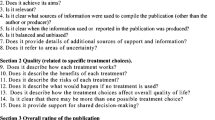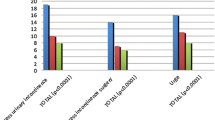Abstract
Introduction and hypothesis
Bladder pain syndrome (BPS) has an impact on quality of life and available treatments often only provide temporary symptomatic relief. The information provided by websites can be valuable for patient education and management. The hypothesis was to assess medical information available on the internet related to bladder pain syndrome in terms of accuracy, credibility, readability and quality.
Methods
A search was performed in the meta-search engine Copernic Agent, using the search terms “bladder pain syndrome, interstitial cystitis, painful bladder syndrome and pelvic pain”, which simultaneously captured websites from a range of engines. Websites in the English language that were open-access were included. The four quality assessments used were: credibility using a ten-point scale, accuracy based on the American Urological Association guidelines, quality using the DISCERN questionnaire and readability using the Flesch Reading Ease Score. Inter-rater agreement was tested by intra-class coefficient (ICC).
Results
Eighteen suitable websites were identified; 7 (39%) were specialist or specific to BPS. The combined mean scores for accuracy, quality, credibility and readability ranged from 83 to 144 for specialist websites and 76 to 137 for non-specialist ones, with a maximum possible score of 208. There was good inter-observer agreement for the assessments performed with an ICC ranging from 0.80 for DISCERN to 0.53 for readability. Specialist websites had higher quality scores (median difference 10, p = 0.07) and readability scores (median difference 5.4, p = 0.05) compared with non-specialist websites whereas credibility and accuracy scores were no different.
Conclusion
We found four websites that fulfilled our criteria for good quality information.


Similar content being viewed by others
Abbreviations
- AUA:
-
American Urological Association
- BPS:
-
Bladder pain syndrome
- CI:
-
Confidence interval
- DMSO:
-
Dimethyl sulfoxide
- FRE:
-
Flesch Reading Ease test
- ICC:
-
Intra-class co-efficient
- PRISMA:
-
Preferred Reporting Items for Systematic Reviews and Meta-analyses
- PROSPERO:
-
International Prospective Register for Systematic Reviews
- SD:
-
Standard deviation
References
van de Merwe JP, Nordling J, Bouchelouche P, Bouchelouche K, Cervigni M, Daha LK et al (2008) Diagnostic criteria, classification, and nomenclature for painful bladder syndrome/interstitial cystitis: an ESSIC proposal. Eur Urol 53(1):60–67
Hanno PM, Burks DA, Clemens JQ, Dmochowski RR, Erickson D, Fitzgerald MP et al (2011) AUA guideline for the diagnosis and treatment of interstitial cystitis/bladder pain syndrome. J Urol 185(6):2162–2170
McMullan M (2006) Patients using the internet to obtain health information: how this affects the patient-health professional relationship. Patient Educ Couns 63(1–2):24–28
Benigeri M, Pluye P (2003) Shortcomings of health information on the internet. Health Promot Int 18(4):381–386
Temml C, Wehrberger C, Riedl C, Ponholzer A, Marszalek M, Madersbacher S (2007) Prevalence and correlates for interstitial cystitis symptoms in women participating in a health screening project. Eur Urol 51(3):803–808, discussion 809
Chien PF, Khan KS, Siassakos D (2012) Registration of systematic reviews: PROSPERO. BJOG 119(8):903–905
Liberati A, Altman DG, Tetzlaff J, Mulrow C, Gøtzsche PC, Ioannidis JP et al (2009) The PRISMA statement for reporting systematic reviews and meta-analyses of studies that evaluate health care interventions: explanation and elaboration. J Clin Epidemiol 62(10):e1–e34
Silberg WM, Lundberg GD, Musacchio RA (1997) Assessing, controlling, and assuring the quality of medical information on the internet: caveant lector et viewor–let the reader and viewer beware. JAMA 277(15):1244–1245
Latthe PM, Latthe M, Khan KS (2000) Quality of medical information about menorrhagia on the worldwide web. BJOG 107(1):39–43
Winker MA, Flanagin A, Chi-Lum B, White J, Andrews K, Kennett RL et al (2000) Guidelines for medical and health information sites on the internet: principles governing AMA web sites. Am Med Assoc JAMA 283(12):1600–1606
Groot D, ter Riet G, Khan KS, Misso K (2001) Comparison of search strategies and quality of medical information of the internet: a study relating to ankle sprain. Injury 32(6):473–476
Kunst H, Groot D, Latthe PM, Latthe M, Khan KS (2002) Accuracy of information on apparently credible websites: survey of five common health topics. BMJ 324(7337):581–582
Murphy R, Frost S, Webster P, Schmidt U (2004) An evaluation of web-based information. Int J Eat Disord 35(2):145–154
Ambre J, Guard R, Perveiler FM, Renner J, Rippen H (1997) White paper: Criteria for assessing the quality of health information on the internet
Hanno P, Lin A, Nordling J, Nyberg L, van Ophoven A, Ueda T et al (2010) Bladder pain syndrome committee of the international consultation on incontinence. Neurourol Urodyn 29(1):191–198
Bernstam EV, Shelton DM, Walji M, Meric-Bernstam F (2005) Instruments to assess the quality of health information on the world wide web: what can our patients actually use? Int J Med Inform 74(1):13–19
Routh JC, Gong EM, Cannon GM, Nelson CP (2011) Does a controversial topic affect the quality of urologic information on the internet? Urology 78(5):1051–1056
Kaicker J, Debono VB, Dang W, Buckley N, Thabane L (2010) Assessment of the quality and variability of health information on chronic pain websites using the DISCERN instrument. BMC Med 8:59
Henderson EM, Rosser BA, Keogh E, Eccleston C (2012) Internet sites offering adolescents help with headache, abdominal pain, and dysmenorrhoea: a description of content, quality, and peer interactions. J Pediatr Psychol 37(3):262–271
Landis JR, Koch GG (1977) The measurement of observer agreement for categorical data. Biometrics 33(1):159–174
Davies L, Ganger K, Drummond M, Saunders D, Beard R (1992) The economic burden of intractable gynaecological pain. J Obstet Gynaecol 12 [Suppl 2]:S46–S54
Henry JL (2008) The need for knowledge translation in chronic pain. Pain Res Manag 13(6):465–476
Corcoran TB, Haigh F, Seabrook A, Schug SA (2009) The quality of internet-sourced information for patients with chronic pain is poor. Clin J Pain 25(7):617–623
de Boer MJ, Versteegen GJ, van Wijhe M (2007) Patients’ use of the Internet for pain-related medical information. Patient Educ Couns 68(1):86–97
Sajadi KP, Goldman HB (2011) Social networks lack useful content for incontinence. Urology 78(4):764–767
Clemens JO, Calhoun EA, Litwin MS, Collins MM (2008) Primary care physician practice patterns in the management of interstitial cystitis/painful bladder syndrome. Neurourol Urodyn 27(2):140–141
Cline RJ, Haynes KM (2001) Consumer health information seeking on the internet: the state of the art. Health Educ Res 16(6):671–692
Acknowledgments
None.
Funding
None.
Ethics
None.
Conflicts of interest
None.
Author information
Authors and Affiliations
Corresponding author
Additional information
PROSPERO registration number
CRD42012003203
Brief summary
Patient-accessible information on the internet related to bladder painsyndrome can be variable in terms of quality, credibility, accuracy and readability
Electronic supplementary material
Below is the link to the electronic supplementary material.
ESM 1
(DOC 63 kb)
Rights and permissions
About this article
Cite this article
Tirlapur, S.A., Leiu, C. & Khan, K.S. Quality of information on the internet related to bladder pain syndrome: a systematic review of the evidence. Int Urogynecol J 24, 1257–1262 (2013). https://doi.org/10.1007/s00192-013-2091-1
Received:
Accepted:
Published:
Issue Date:
DOI: https://doi.org/10.1007/s00192-013-2091-1




